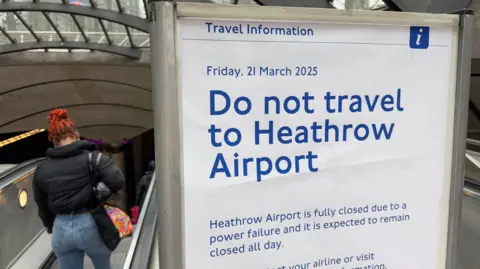Five things we now know about the fire that shut Heathrow down
 Reuters
ReutersA report into a fire at an electricity substation that resulted in Heathrow Airport shutting down for nearly a day, causing chaos for more than 200,000 passengers, has been released.
The National Energy System Operator (NESO) identified the likely cause of the fire, and said that National Grid which operates the substation was warned about a fault seven years ago.
Here are five key findings from the report.
1. The fire was caused by moisture
The NESO report answered one of the key questions – what caused the fire?
The device which caught fire was a "supergrid transformer", which takes high voltage electricity from the transmission grid and reduces it to a lower voltage for the next stage of its route to Heathrow Airport and surrounding houses.
Inspectors said the likely cause was moisture getting into the high-voltage "bushing" – insulation around the connections.
That caused a short-circuit and "arcing" - electric sparks like those in a spark plug - which resulted in a "catastrophic failure".
That caused the oil which is used to cool the transformer to catch fire, and took two transformers offline, cutting power to Heathrow.
2. National Grid knew about the problem seven years before the fire
The report said signs of moisture were detected at North Hyde in July 2018.
National Grid's guidance said these were "an imminent fault" that should be replaced.
But the issue wasn't fixed at the time.
In 2022, basic maintenance on the transformer was deferred.
Multiple further attempts were made to schedule maintenance, but none went ahead.
3. Heathrow knew a problem with one of its three grid connections would close the airport
Heathrow uses as much electricity as a small city, and it has three connections to the national grid.
But it knew that if one of them went down, it would have to close the airport for 10 to 12 hours while key systems were connected to the other sources of supply.
It did not think it was a likely scenario, so it was not considered worthwhile to spend the money to fix it – which Heathrow has previously said would have cost a billion pounds.
NESO said having three connections to the grid meant there were "opportunities" to improve Heathrow's resilience of supply.
4. National Grid didn't know how important the substation was
National Grid and the local network operator SSEN knew that electricity from North Hyde went to Heathrow Airport.
But they did not know that Heathrow would have to shut down if that supply was interrupted.
Energy suppliers do not currently know if their customers are counted as "critical national infrastructure (CNI)" – sectors such as transport, defence, government or communications.
The report calls for better communications between CNI operators and their energy suppliers to ensure that supplies do not get interrupted.
5. Heathrow is not happy
Heathrow came under a lot of criticism after the fire - including the revelation that the chief executive Thomas Woldbye was asleep in bed when the decision was taken to close the airport.
NESO said its report was not written to "apportion blame", but Heathrow says it is now considering legal action against National Grid.
In its view the report described "clear and repeated failings" which "could and should" have prevented the fire.
It said it expected National Grid to "take responsibility for those failings."
National Grid said it had a comprehensive maintenance programme, and would co-operate closely with the Ofgem investigation.
